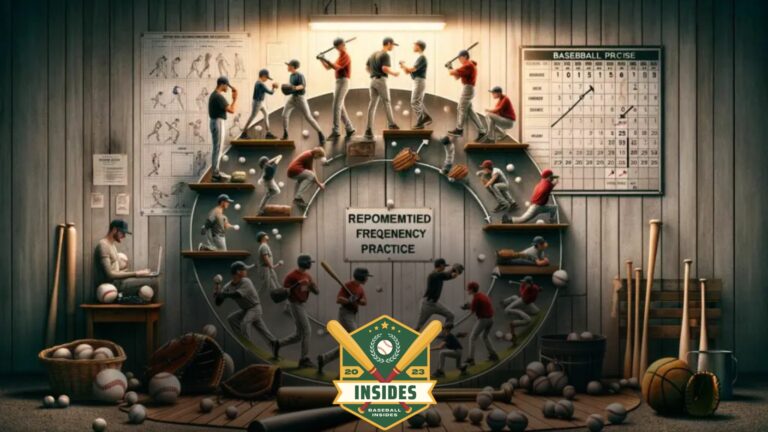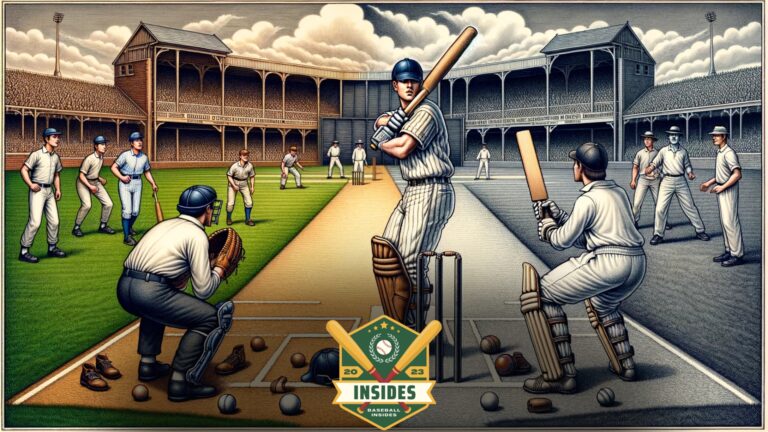
In this article:
If you’ve ever watched a baseball game or followed it, you may have encountered the abbreviation “TB” and wondered what it means.
In baseball, TB stands for “total bases,” which refers to the number of bases a batter reaches on a particular hit. It’s an essential statistic that helps measure a player’s offensive contribution and power.
In the game of baseball, each base represents a different value. When a batter hits a home run, they touch all four bases and earn four total bases.
Similarly, a triple results in three total bases, a double in two, and a single in one.
It’s important to note that walks, steals, sacrifices, and other non-hit advancements do not count toward the total bases.
Understanding the concept of total bases is crucial for analyzing a player’s performance and comparing offensive statistics.
In this article, we’ll delve deeper into the significance of total bases and how they contribute to evaluating a player’s impact on the game.
So, let’s step up to the plate and uncover the meaning of TB in baseball!
What is TB in Baseball?
Have you ever watched a baseball game and wondered, “What does TB mean?” Well, get ready to unlock the mystery!
TB stands for “Total Bases,” and it’s a key statistic that measures a batter’s offensive prowess and the extent of their impact on the game.
So, let’s dive into TB and discover what makes it an essential concept in baseball.
When we talk about Total Bases, we’re referring to the sum of a batter’s hits in a game or over a specific period. It goes beyond counting the number of times a batter reaches base—it’s about quantifying the impact of those hits.
TB accounts for the distance a player travels around the bases, measuring their hits’ power, speed, and consistency.
In baseball, four types of hits contribute to a player’s TB: singles, doubles, triples, and home runs. Each hit represents different bases, with singles accounting for one base, doubles for two, triples for three, and home runs for four.
By adding up the bases achieved from each hit, we arrive at the batter’s Total Bases.
Total Bases also allow for meaningful comparisons between players. By comparing their TB numbers, we can gauge different hitters’ effectiveness and contributions to the game.
It’s a metric that helps determine the most dominant offensive players, the leaders in home runs, the kings and queens of extra-base hits, and the players who consistently find themselves on the bases.
While exploring the structure of baseball teams, one might wonder, ‘How Many Baseball Players Are On A Team?’ and how this affects team dynamics and strategies.
How TB Influences Fantasy Baseball?
Welcome to the world of fantasy baseball, where Total Bases (TB) is important. Strap on your virtual manager’s cap, and let’s explore how TB can make or break your fantasy team!
In fantasy baseball, you become the mastermind behind your team, hand-picking players from various real-life teams to assemble your dream roster.
As you construct your lineup, you’ll notice that TB plays a significant role in shaping your strategy and determining your team’s success.
Total Bases are not just another statistic in fantasy baseball; they are a key ingredient in scoring points.
Each hit a player makes contributes to their Total Bases count, and those bases can lead to valuable points for your fantasy team. The more bases your players accumulate, the more points they rack up for your squad.
Why does TB matter so much in fantasy baseball? It reflects a player’s ability to make impactful hits, which translate to more runs and RBIs, two other crucial fantasy scoring categories.
When your players are consistently racking up Total Bases, they’re generating points directly and setting the stage for potential runs and RBIs, which can further boost your fantasy team’s score.
Total Bases also give you an edge when it comes to player comparisons. In fantasy baseball, it’s all about finding the hidden gems, those players who can significantly impact your team without grabbing all the spotlight.
By analyzing a player’s TB numbers, you can identify those hidden heroes who consistently contribute with extra-base hits, even if they may not be known for their home run prowess.
Famous TB Moments in Baseball History
Baseball has a storied history filled with unforgettable moments that have shaped the game and left fans in awe.
Among these cherished memories are those extraordinary instances when players have achieved remarkable Total Bases (TB) numbers, etching their names into the annals of baseball history.
Let’s journey through time and relive some of the most famous TB moments that have captivated fans for generations.
“The Iron Horse’s Gallant Effort” – June 3, 1932:
In a game against the Detroit Tigers, the legendary Lou Gehrig showcased his power and determination by hitting four consecutive home runs, resulting in a stunning 16 Total Bases. This astounding display of hitting prowess solidified Gehrig’s status as one of the greatest players of his era.
“A Day of Unbelievable Hits” – September 17, 1968:
The year 1968 witnessed the “Year of the Pitcher,” but on this particular day, the Baltimore Orioles’ Frank Robinson defied the odds. Robinson smashed two grand slams and a double, accumulating 14 Total Bases in a single game. It was a historic performance that showcased his offensive brilliance.
“The Sultan of Swat’s Masterpiece” – May 21, 1927:
No list of famous TB moments would be complete without mentioning the iconic Babe Ruth. In a game against the St. Louis Browns, Ruth blasted three home runs, including a grand slam, amassing an awe-inspiring 13 Total Bases. This remarkable feat highlighted Ruth’s unparalleled ability to dominate the game.
“A Triple Delight” – July 25, 2009:
On this summer day, the Colorado Rockies’ Carlos Gonzalez displayed his speed and agility by hitting for the cycle—collecting a single, double, triple, and home run in a single game. Gonzalez’s feat earned him an impressive 10 Total Bases and cemented his place in baseball history as one of the few players to achieve this rare accomplishment.
“A Rookie’s Grand Slam Extravaganza” – September 17, 1996:
Derek Jeter, a rookie shortstop for the New York Yankees, made a lasting impression with his incredible performance against the Kansas City Royals. Jeter hit a grand slam, a triple, and a double, accumulating an outstanding 10 Total Bases. It was a glimpse of the greatness to come from the future Yankees captain.
“The Night of 6 Extra-Base Hits” – September 10, 1999:
Vladimir Guerrero, known for his aggressive and fearless approach at the plate, had a historic night against the Toronto Blue Jays. Guerrero belted two home runs, three doubles, and a triple, resulting in an extraordinary 14 Total Bases. It was an awe-inspiring display of power and skill.
These famous TB moments transcend the confines of statistics and numbers. They represent unforgettable athletic prowess, power, and sheer brilliance on the baseball diamond.
They remind us of the magic that unfolds when players rise to the occasion and deliver performances that leave an indelible mark on the sport.
Understanding baseball statistics can be complex, but grasping concepts like ‘What is a Hold in Baseball?‘ sheds light on the intricacies of pitching and game strategy.
TB in Different Baseball Leagues
Total Bases (TB) is a universal metric that transcends the boundaries of individual baseball leagues.
Whether it’s the Major Leagues, minor leagues, international leagues, or youth leagues, TB is a vital statistic that measures a player’s offensive impact.
Let’s journey through various baseball leagues and explore how TB holds significance in each.
1. Major League Baseball (MLB)
MLB showcases the highest level of competition at the pinnacle of the baseball world. Total Bases are central in evaluating player performance and determining offensive prowess.
From sluggers who dominate the home run leaderboard to hitters with a penchant for extra-base hits, TB is a crucial statistic that helps define the success and value of players in the MLB.
2. Minor League Baseball (MiLB)
As a developmental system for MLB, minor league baseball provides a platform for up-and-coming players to showcase their skills.
Total Bases in the minor leagues serve as a measuring stick for prospects, allowing teams and scouts to evaluate their ability to generate offense and contribute to their respective organizations.
Impressive TB numbers in the minors often indicate promising talent ready to impact at the highest level.
3. International Baseball Leagues
Beyond the borders of the United States, baseball enjoys widespread popularity in countries worldwide. International baseball leagues like Nippon Professional Baseball (NPB) in Japan or the Korean Baseball Organization (KBO) in South Korea have dedicated fan bases.
Total Bases hold similar significance in these leagues, providing a metric to assess the power and offensive capabilities of players who entertain fans globally.
4. Collegiate Baseball
College baseball serves as a breeding ground for future MLB stars, and Total Bases remains a critical statistic in evaluating player performance at the collegiate level.
As players compete in NCAA or other collegiate leagues, TB helps scouts and coaches identify top talents who can make an impact with their hitting prowess.
5. Youth Leagues
Even in baseball’s youngest divisions, Total Bases are an important marker of a player’s development and offensive potential.
Whether it’s Little League, Babe Ruth League, or other youth organizations, TB offers a glimpse into a player’s ability to make impactful hits and contribute to their team’s success.
Regardless of the league, Total Bases remains a fundamental statistic capturing a player’s offensive impact.
When discussing equipment, a common question arises: ‘Why Does Little League Use Aluminum Bats?’, a choice that significantly influences the game’s playability and safety for younger participants
How to Improve TB as a Player?
If you’re a baseball player looking to make a bigger impact at the plate and increase your Total Bases (TB), you’ve come to the right place. Enhancing your TB numbers requires skill, technique, and strategy.
Let’s dive into some valuable tips and techniques that can help you improve your TB and become a more impactful hitter.
1. Develop Power and Bat Speed
Increasing your power and bat speed is essential for generating extra-base hits and maximizing your TB. Incorporate strength training exercises into your workout routine to build strength and explosive power.
Focus on exercises that target your core, legs, and upper body, as they are crucial in generating the necessary bat speed to drive the ball with authority.
2. Master Your Swing Mechanics
Having solid swing mechanics is the foundation for success at the plate. Work with a knowledgeable coach or instructor to refine your swing and ensure you use proper technique.
Focus on generating maximum power and contact by using your lower body to generate force, maintaining balance, and staying through the ball with your swing. Correct mechanics can lead to cleaner and more powerful hits and higher TB.
3. Study Pitching Patterns
Understanding the tendencies and patterns of opposing pitchers can give you an advantage at the plate. Analyze scouting reports, study video footage, and closely examine how pitchers attack hitters.
Look for patterns in pitch selection, locations, and sequencing. By recognizing and anticipating certain pitches or pitch locations, you can make more solid contact, increase your chances of hitting extra bases, and boost your TB.
4. Develop Plate Discipline
Improving your plate discipline is crucial for achieving more favorable hitting counts and getting pitches you can drive. Work on recognizing pitches out of the pitcher’s hand early and develop the ability to lay off pitches outside the strike zone.
By being patient and selective, you can wait for pitches in your wheelhouse, increasing the likelihood of making solid contact and driving the ball for extra bases.
5. Study and Emulate Successful Hitters
Learn from the best by studying successful hitters who consistently generate high TB numbers. Analyze their approach, swing mechanics, and mindset.
Pay attention to their ability to drive the ball to all fields, their aggressiveness on pitches in their power zones, and their ability to consistently square up the ball.
Emulate and incorporate their techniques into your game, adapting them to fit your style and strengths.
6. Focus on Gap-to-Gap Hitting
While hitting home runs can certainly contribute to high TB numbers, don’t overlook the value of hitting the gaps. Focus on driving the ball into the gaps between outfielders, aiming for doubles and triples.
By honing your ability to hit all fields, you increase your chances of finding open spaces and maximizing your TB potential.
7. Improve Your Speed and Base-Running Skills
Improving your speed and base-running skills can help stretch hits into extra bases. Work on your agility, explosiveness, and base-running technique to become a more effective runner.
By taking an extra base whenever possible, you increase your chances of adding to your TB count and putting yourself in a scoring position.
Remember, improving your TB as a player takes time, dedication, and practice. Work on these tips consistently and seek feedback from coaches or instructors to refine your skills.
Do Walks Count as Total Bases?
In baseball, walks do not count as total bases. Total bases refer to the number of bases a player advances on hits, which includes singles, doubles, triples, and home runs.
A walk, also known as a base on balls, occurs when a pitcher throws four pitches outside the strike zone, and the batter does not swing.
As a result, the batter is awarded first base without putting the ball in play. Walks are considered to be a free pass to first base.
While a walk does not contribute to a player’s total bases, it still has value in advancing base runners and potentially leading to runs. When a batter walks, it increases the likelihood of scoring runs for their team as they occupy first base.
Additionally, walks can impact a pitcher’s pitch count and force them to throw more pitches, potentially tiring them out and affecting their performance.
Total bases are used to calculate several statistics in baseball, such as slugging percentage, which measures a player’s ability to hit for power.
Rather than walks, hits are the primary factor in determining a player’s total bases.
Conclusion
In baseball, the acronym TB stands for “total bases.” A statistic measures a batter’s overall offensive production by counting the number of bases he reaches on hits. Total bases include the following:
- One base for a single
- Two bases for a double
- Three bases for a triple
- Four bases for a home run
By calculating the total bases, we gain insight into players’ ability to generate extra-base hits and contribute to their team’s scoring opportunities.
This statistic is valuable in assessing a batter’s power and overall offensive impact on the game.
With TB, baseball enthusiasts and analysts can better understand and evaluate a player’s performance at the plate.
FAQs
What Does the TB Stand for in Baseball?
In baseball, TB stands for “Total Bases.” It is a statistical metric that quantifies a player’s offensive performance by summing up the number of bases they gain from their hits (singles, doubles, triples, and home runs).
Who Has the Most TB in MLB?
In September 2021, Hank Aaron was the player with the most Total Bases (TB) in Major League Baseball (MLB) history. He had an illustrious career and set the record for the most total bases, accumulating an impressive tally throughout his time in the league.
Does a BB Count as a TB in Baseball?
No, a BB (Base on Balls), commonly known as a walk, does not count as a TB (Total Base) in baseball. A walk is when a pitcher throws four balls out of the strike zone, and the batter is awarded first base. While a walk helps a player reach base safely without putting the ball in play, it does not contribute to their total bases.
What is a BB in Baseball?
In baseball, BB stands for “Base on Balls,” a “walk.” A walk occurs when a pitcher throws four balls outside the strike zone to a batter. When a batter receives a walk, they are awarded first base, allowing them to advance without putting the ball in play.






